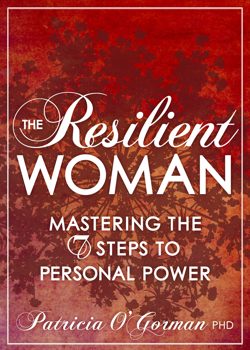 The Resilient Woman: Mastering the 7 Steps to Personal Power (publication date 3.5.13) by Health Communications, Inc. (HCI Books), the publisher best known for the original Chicken Soup for the Soul series and other New York Times bestsellers.
The Resilient Woman: Mastering the 7 Steps to Personal Power (publication date 3.5.13) by Health Communications, Inc. (HCI Books), the publisher best known for the original Chicken Soup for the Soul series and other New York Times bestsellers.
Dr. Patricia O’Gorman’s newest book, her second on women and resilience, is The Resilient Woman: Mastering the 7 Steps to Personal Power. Dr. O’Gorman’s development of the revolutionary term—girly thoughts is changing how women see themselves through providing a way for women to articulate just what is the problem. The answer: their girly thoughts – how they internalize the subtle and not-so-subtle limiting messages from society that tell them how to, and how not to act, what to aspire to, and what to avoid; how they use these internal messages to limit themselves and to self-sabotage; and how they take-to-heart the consequences for not listening to these messages — whatever goes wrong in their life is their fault from their partner’s affair, to their boss not taking them seriously because he’s threatened by the fact that they may be smarter than he is!
She also provides a solution — the way out — through directing them to consciously develop and use their resilience to help themselves — as opposed to just using their inner strength to help their family, their employer, their community, and their girlfriends, with their real needs coming last, and that is even if their needs make it on the list. She encourages women that the conscious use of their resilience is a game-changer! This is a message that is resonating with women around the world.
The Resilient Woman is about how women can consciously use their skills, their resilience, to counter pervasive societal forces their girly thoughts, and grow:
Trying to make others happy seems to be part of a woman’s nature. But what happens when that ‘need to please’ goes awry and interferes with a woman’s success, not only in her professional life but her personal life, when a woman pushes herself harder, ignoring her own needs? What if she thinks self-sabotaging, self-limiting girly thoughts—If only I was thinner . . . younger . . . prettier . . . into kinkier sex, didn’t want children, wasn’t so brainy, maybe? noted psychologist and author Dr. Patricia O’Gorman answers these questions and more in her groundbreaking book, The Resilient Woman. [pullquote]The Resilient Woman is about how women can consciously use their skills, their resilience, to counter pervasive societal forces their girly thoughts, and grow.[/pullquote]
In this book, Dr. O’Gorman offers a thoughtful analysis of the causes of girly thoughts as well as in-depth self-evaluation assessments any woman can use to identify her personal strengths, weaknesses, and resilience style. She created seven daily steps that offer concrete strategies for women to create and strengthen their own resilience. The book (which began as a revision of her groundbreaking work Dancing Backwards in High Heels) is an important tool for self-growth for women of any age.
In this Q&A, Dr. O’Gorman explains how girly thoughts and being resilient are some of the characteristics also found in lesbians and how straight women can learn from lesbians when it comes to resiliency and girly thoughts.
Q. What inspired you to write this book?
A. A concern that even with all the gains that women have made that there is one that they have yet to embrace, the conscious use of their resilience to make their life easier. My mission is to help women consciously use their strengths, their resilience, to feel more in control, more fulfilled, and even happier, and to use their resilience to be successful in their life – in their personal life and in their professional life.
Q. Who should read your book?
A. Women of all ages, from adolescent girls to women in post menopause (I do address coming into your own sexually as you age.) Consciously using their power, in all aspects, in all the seasons of their lives, is a goal I urge all women to embrace.
Q. What are girly thoughts?
A. These are societally driven messages that tell women what they can do, and how they should look, and then blame women for the unfairness that they encounter as being their fault due to their not being: pretty enough, thin enough, young… or due to their aiming too high. And women are not even aware that they internalize these messages. As a result they unconsciously judge their self-worth according to how close they come to these ideals, and feel crappy about how they look if they don’t measure up due to their hair, how tight their pants are, a new wrinkle or zit, in essence sabotaging themselves in feeling powerful as they go through their day.
Q. What is resilience?
A. Resilience are those strengths and skills we develop when we are faced with hardship, when we find ourselves dealing with adversity, when we face those challenges that we wish we never had to experience. These are the behaviors, the awareness, the insight, the inner capacities that we develop that help get us through these hard times. And the good news is that developing these inner muscles can enhance how we feel about ourselves. We can a new sense of who we are, one that may even impress us about what we are capable of achieving. As seen in the statement we often hear: If I can do this I can do anything! The trick in developing conscious resilience is to acknowledge to ourselves the skills we have developed, and to own that once we develop these skills we can use them again, wherever we need to, to speak up about our needs, to push for ourselves professionally.
Q. Why is it so hard for women to own their resilience?
A. Women (and men) are powerfully influenced by our culture. We have so many messages that women are many wonderful things: caring, beautiful, motherly, but being strong, and knowing it, and using it, unfortunately isn’t one of them. And men have their version of this as well. Men aren’t supposed to be vulnerable, even though women say they want this. So for a woman to be strong, and know it, or for a man to have feelings and show it, makes them stand outside this subtle cultural norm.
Q. Do Lesbians have resilience?
I think a major part of the resilience shown by lesbians is that they have had to push through their ‘girly thoughts’ and make peace with who they are, as opposed to who they are supposed to be=girly thoughts. This is a part of being a lesbian that needs to be celebrated and should be used as an example for other women.
Q. So, straight women could learn from lesbians then?
A. If lesbian women can do this — YOU CAN TOO! It’s quite a message. Lesbians have an important model for doing this.
Q. What do you mean by personal power?
A. Personal power is the result that comes from our consciously developing our resilience. So many times women are not in touch with their power, they do, they get through, but they don’t allow themselves to understand that they have mastered a difficult, even a very difficult situation, and they have survived, and perhaps even thrived. And that what they have learned by going through this challenge, they can use, knowingly, the next time they are faced with a test, allowing themselves to feel more confident as they purposefully apply what they have learned works for them. Intentionally handling a rough situation in a way that what will work for you, now that’s power.
Q. What are the 7 Steps to Personal Power?
Step One–Make Your Crises Meaningful: Choose to Develop Conscious Resilience
Step Two—Uncover Your Hidden Resilient Voice: Use Your Own Wisdom to Determine What Is Right for You
Step Three—Create Helpful Boundaries: Take Charge and Stop Setting Yourself Up
Step Four—Protect Your Heart: Love Resiliently
Step Five—Become Strong in the Hurt Places: Heal Your Wounded Self
Step Six—Think Positively: It’s the Best Revenge
Step Seven—Develop Gratitude for Who You Are and What You Have Learned
Q. What is the connection between Resilience and girly thoughts?
A. Girly thoughts represent anti-resilience. Girly thoughts sap women of their power, turning them into someone who outwardly may look powerful, accomplished, having it all together, and yet inwardly feel as if they are a mess. Resilience is the way out. Owning our resilience allows us to begin to define ourselves, to derive satisfaction and fulfillment based upon how we see ourselves, and not just be held hostage by how society (others) may see, or evaluate us.
Q. Do we see girly thoughts portrayed in the media?
A. We see this frequently with the focus on celebrity women’s bodies, how much weight they have gained, their wrinkles, how they look without makeup, how they look in a bathing suit. Their looks becomes a major focus when their husbands have affairs with younger women, as if this explains something about their deficits, making them somehow responsible for their husband’s actions. And we also see this in how women politicians, and women executives are criticized, and even joked about, in the media. There is such a focus on youth and thinness in media representatives, that any exception to this, such as Candy Crowley, CNN, immediately come to mind.
Q. How does the media enforce the notion of girly thoughts?
A. Women tend to be very social and are media consumers. Just look at the number of publications directed specifically at women that focus on how women look — clothes, makeup, body. Understand that there are whole industries devoted to helping to shape what women wear, what color nail polish they use, what foods they should eat. As a result women are bombarded by images of the feminine ideal: on TV, in Magazines, Online, in the Movies, this results in women being very tuned into what society tells them they should do, and should not do, how they should look, and makes them aware of the consequences when they do not follow these sanctions… they will loose their man … they won’t be liked, they’ll be ridiculed, hence all the advice columns in all those women-focused publications.
Q. What impact do these media representations of girly thoughts have on the average woman?
A. Women try to measure up to the ideals that surround them, and most often come up short, resulting in their feeling less than, as they cannot meet these ideals of the perfect body, buy the required accessories, be successful and be liked, or stay forever young. On one level this is depressing leading women to try to sooth themselves through chocolate, or other foods, alcohol or drug use, or excessive exercise resulting in the impact of girly thoughts being that many women give up taking care of themselves, because they don’t see the mid ground between the ideal, and living a healthy life.
Q. You have exercises throughout the book. What role do they serve?
A. The exercises allow each woman to go deeper into each area of developing resilience, to individualize the material and make it personal for them. The exercises also allow women to have a way of revisiting how they are developing and using their resilience after they have faced another challenge be this personal or professional. In this they develop their own personal roadmap.
Q. How has writing this book affected your work as a psychologist?
A. I now have the term girly thoughts, to help describe the complex interaction of self and society that leaves so many women feeling less than. And women love it. It gives them a way of describing this type of unhelpful self-sabotaging thinking, so that they can catch it, and stop it. This allows me to be even clearer that women need to use their strengths to help themselves, and not just use their strengths for others, or their job. I help women see the choices they are making, how these choices will impact them personally, and how they can use their already developed strengths, and develop new strengths (through the use of my 7 steps), to address the challenges that are before them.
Q. What mental health issues do women risk by not being in touch with their resilience?
A. If a woman is not in touch with her strengths, if she isn’t using this vital part of who she is to inform her decision-making, including her decision to take care of herself, she is probably not in touch with other parts of who she is for example, her feelings, and her own needs — it is difficult to stuff your strengths and not to be also be stuffing other parts of who you are. When women are not in touch with their strengths they are silencing themselves, clearly not how a woman wants to see herself, but it is how she is treating herself when she doesn’t integrate her strengths, her resilience with the rest of who she is.
For more information about the book, how to buy it, or information about the author, visit Amazon, Barnes and Noble, the author’s website www.patriciaogorman.com, this blog http://thepowerfulwoman.net , or call 518. 392. 2902.
[From a News Release]







